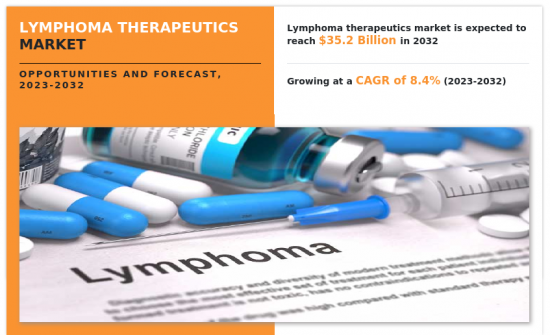PUBLISHER: Allied Market Research | PRODUCT CODE: 1298353

PUBLISHER: Allied Market Research | PRODUCT CODE: 1298353
Lymphoma Therapeutics Market By Disease Type, By Treatment Type, By Route of Administration, By Distribution Channel : Global Opportunity Analysis and Industry Forecast, 2023-2032
The Lymphoma Therapeutics Market is valued for $15,691.45 million in 2022 and is estimated to reach $35,207.45 million by 2032, exhibiting a CAGR of 8.4% from 2023 to 2032. Lymphoma is a type of cancer that affects the lymphatic system, which is a part of the immune system that helps to fight infections and other diseases. Lymphomas arise when certain types of white blood cells called lymphocytes undergo abnormal changes and begin to grow and multiply uncontrollably. Lymphoma therapeutics refers to various types of treatments that are used to treat lymphoma. Some of the various types of lymphoma therapeutics can include chemotherapy, radiation therapy, immunotherapy, targeted therapy, stem cell transplantation, and sometimes surgery.

The key factor that drives the growth of the lymphoma therapeutics market is the growing pipeline of lymphoma therapeutics. For instance, according to GlobalData report in March 2023, larotrectinib sulfate by Bayer AG is under clinical development and currently in phase II for non-Hodgkin lymphoma. The phase II drugs for non-Hodgkin lymphoma have a 40% phase transition success rate (PTSR) indication benchmark for progressing into phase III.
Moreover, significant rise in prevalence of lymphoma and surge in geriatric population notably contribute toward the growth of the market. Furthermore, increase in investment in R&D activities and favorable government policies for the approval of novel drugs to treat non-Hodgkin and Hodgkin lymphoma are expected to open new avenues for the growth of the global market during the forecast period.
However, the high cost of available treatments and lack of awareness about lymphoma and availability of different options to treat lymphoma among people hamper the market growth. Conversely, surge in geriatric population which is more susceptible to lymphoma and development of effective medicines that are accessible and safe for patients are expected to provide lucrative opportunity for the growth of the market during the forecast period.
The lymphoma therapeutics market is segmented into disease type, treatment type, route of administration, distribution channel, and region. By disease type, the market is bifurcated into Hodgkin lymphoma and non-Hodgkin lymphoma. On the basis of treatment type, it is fragmented into immune therapy, chemotherapy, targeted therapy, and radiation therapy. Depending on the route of administration, the market is categorized into oral route and injectables. As per distribution channel, it is segregated into hospital pharmacies, retail pharmacies, and online pharmacies. Region wise, it is analyzed across North America, Europe, Asia-Pacific, and LAMEA.
North America garnered the maximum share of the lymphoma therapeutics market share in 2022 and is anticipated to remain dominant during the forecast period. This is attributed to increase in prevalence of non-Hodgkin lymphoma in the region and surge in awareness among the population regarding the available diagnostic technologies and treatment alternatives for lymphoma. Furthermore, availability of reimbursement policies and surge in number of clinical trials owing to rise in investment by key market players in R&D activities are expected to fuel the market growth.
Asia-Pacific is expected to register the fastest CAGR during the forecast period owing to rise in geriatric population and strong pipeline of lymphoma drugs in developing countries. Furthermore, increase in prevalence of lymphoma and rise in awareness about treatment options available for lymphoma in the developing countries such as India, China, and South Korea contribute toward the growth of the market in this region.
The key players that operate in the lymphoma therapeutics market are: AstraZeneca Plc, Bayer AG, Bristol Myers Squibb Co., Eli Lily and Company, F Hoffman La Roche Ltd, Johnson & Johnson, Gilead Sciences, Inc., Seagen Inc., Teva Pharmaceutical Industries Ltd., and Pfizer Inc.
Key Benefits For Stakeholders
- This report provides a quantitative analysis of the market segments, current trends, estimations, and dynamics of the lymphoma therapeutics market analysis from 2022 to 2032 to identify the prevailing lymphoma therapeutics market opportunities.
- The market research is offered along with information related to key drivers, restraints, and opportunities.
Key Market Segments
By Disease Type
By Treatment Type
By Route of Administration
By Distribution Channel
By Region
Key Market Players:
TABLE OF CONTENTS
CHAPTER 1: INTRODUCTION
- 1.1. Report description
- 1.2. Key market segments
- 1.3. Key benefits to the stakeholders
- 1.4. Research Methodology
- 1.4.1. Primary research
- 1.4.2. Secondary research
- 1.4.3. Analyst tools and models
CHAPTER 2: EXECUTIVE SUMMARY
- 2.1. CXO Perspective
CHAPTER 3: MARKET OVERVIEW
CHAPTER 4: LYMPHOMA THERAPEUTICS MARKET, BY DISEASE TYPE
CHAPTER 5: LYMPHOMA THERAPEUTICS MARKET, BY TREATMENT TYPE
CHAPTER 6: LYMPHOMA THERAPEUTICS MARKET, BY ROUTE OF ADMINISTRATION
CHAPTER 7: LYMPHOMA THERAPEUTICS MARKET, BY DISTRIBUTION CHANNEL
CHAPTER 8: LYMPHOMA THERAPEUTICS MARKET, BY REGION
CHAPTER 9: COMPETITIVE LANDSCAPE
CHAPTER 10: COMPANY PROFILES
LIST OF TABLES
- TABLE 01. GLOBAL LYMPHOMA THERAPEUTICS MARKET, BY DISEASE TYPE, 2022-2032 ($MILLION)
- TABLE 02. LYMPHOMA THERAPEUTICS MARKET FOR HODGKIN LYMPHOMA, BY REGION, 2022-2032 ($MILLION)
- TABLE 03. LYMPHOMA THERAPEUTICS MARKET FOR NON-HODGKIN LYMPHOMA, BY REGION, 2022-2032 ($MILLION)
- TABLE 04. GLOBAL LYMPHOMA THERAPEUTICS MARKET, BY TREATMENT TYPE, 2022-2032 ($MILLION)
- TABLE 05. LYMPHOMA THERAPEUTICS MARKET FOR IMMUNE THERAPY, BY REGION, 2022-2032 ($MILLION)
- TABLE 06. LYMPHOMA THERAPEUTICS MARKET FOR CHEMOTHERAPY, BY REGION, 2022-2032 ($MILLION)
- TABLE 07. LYMPHOMA THERAPEUTICS MARKET FOR TARGETED THERAPY, BY REGION, 2022-2032 ($MILLION)
- TABLE 08. LYMPHOMA THERAPEUTICS MARKET FOR RADIATION THERAPY, BY REGION, 2022-2032 ($MILLION)
- TABLE 09. GLOBAL LYMPHOMA THERAPEUTICS MARKET, BY ROUTE OF ADMINISTRATION, 2022-2032 ($MILLION)
- TABLE 10. LYMPHOMA THERAPEUTICS MARKET FOR ORAL ROUTE, BY REGION, 2022-2032 ($MILLION)
- TABLE 11. LYMPHOMA THERAPEUTICS MARKET FOR INJECTABLE, BY REGION, 2022-2032 ($MILLION)
- TABLE 12. GLOBAL LYMPHOMA THERAPEUTICS MARKET, BY DISTRIBUTION CHANNEL, 2022-2032 ($MILLION)
LIST OF FIGURES




